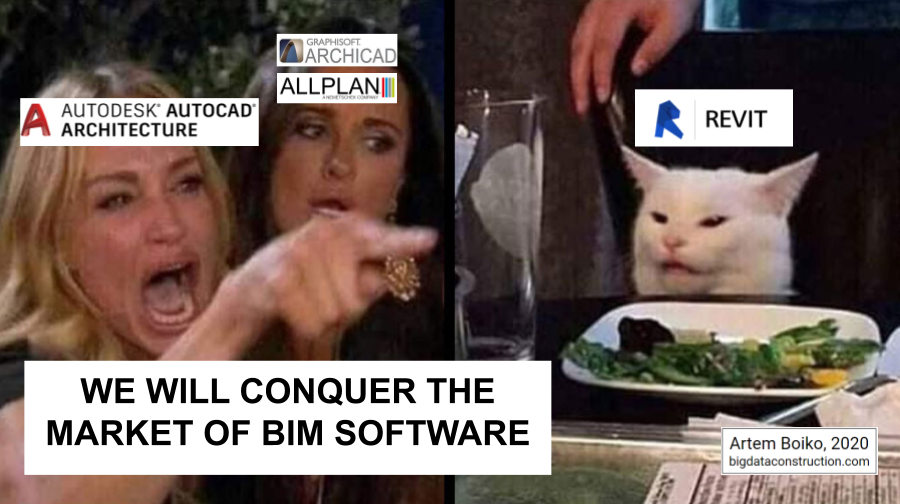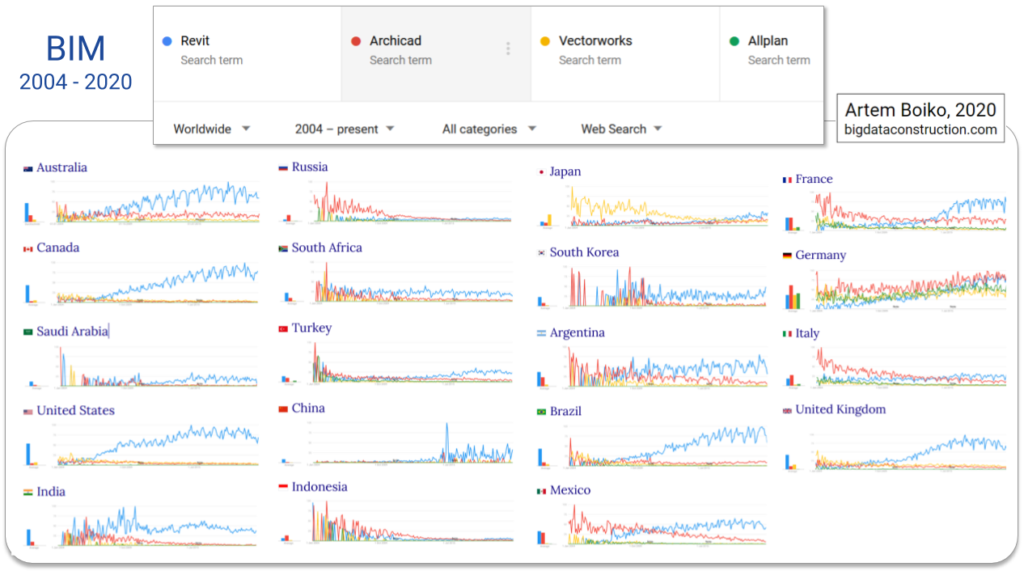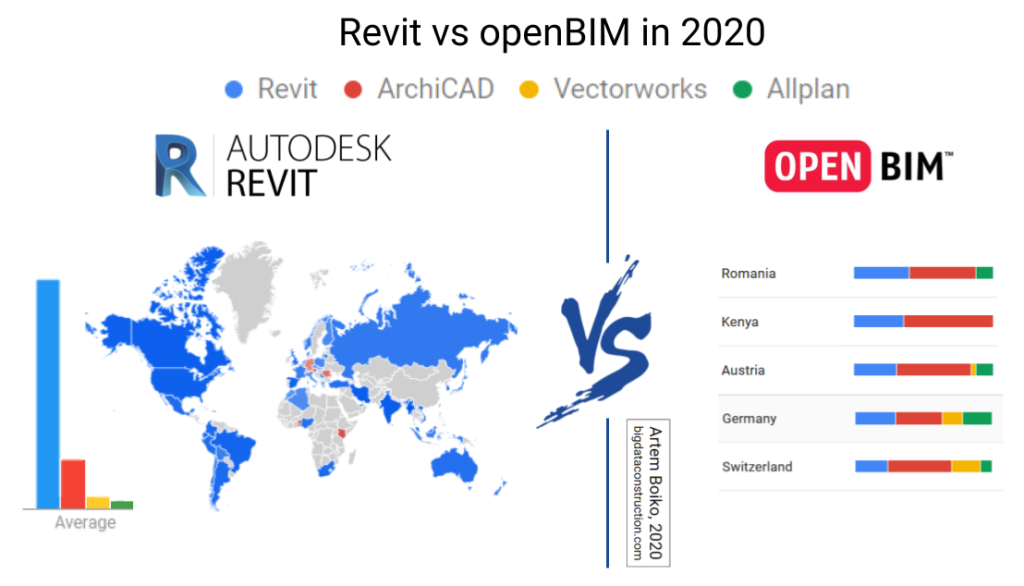Lobbyist Wars and the Development of BIM. Part 2: open BIM VS closed BIM. Revit vs ArchiCAD and Europe VS the Rest of the World

In the first part, we talked about the emergence of the STEP, IFC formats and the creation of the buildingSMART organization. The article also talked about the birth of a new planning tool – the Revit program – and about the new functions given by the developers to the program, thanks to which, since 2010, Revit has confidently become the leader in the design market worldwide.
If you follow the main trends in BIM planning around the world, you will notice an incredible bias in the development of BIM technologies in certain developed countries. What explains this difference in planning technologies, on which 5 to 20% of the GDP of each country in the world depends?

In this article we will take a look at where the BIM CAD software market is headed today. What BIM CAD programs are chosen by designers in different countries of the world and how the planning world has radically changed over the past 15 years.
Which BIM software to use? Overview of tools for BIM planning.
Using search data from Google, let’s look at the development of the popularity of the main 3D design software around the world by years, from 2004 to 2020. Objective indicators of Google Trends show the relative popularity of the query: 100 points mean the maximum interest in the topic, and 0 – insufficient information on her.
The 2008 crisis gave impetus to an inefficient construction industry, which was forced to become “more efficient”: reducing on average 30% of the workforce employed in the industry (more on this in my article: “The construction sector is dying out. The COVID-19 crisis, growing problems and new opportunities ”) and finally turning our eyes to new methods and planning tools – BIM, which allow to increase productivity already today by at least 10% and profitability (ROI) with new investments when implementing BIM by 500%.
Until 2008, the leaders in 3D planning were Vectorworks (originally known as MiniCAD), developed by Vectorworks, Inc. (originally Diehl Graphsoft) in the USA, and Archicad, developed by Graphisoft, a Soviet startup headquartered in Budapest, Hungary. In 2000, Nemetschek buys Diehl Graphsoft, the makers of Vectorworks, which later rebranded in 2016 to Vectorworks, Inc. In 2007, the German company Nemetschek buys out Graphisoft, and apparently with the purchase of the company, the development of new tools for Archicad has slowed down. At the same time, Revit began to actively pull ahead immediately after the end of the 2008 global crisis.
At the moment, Revit has almost a fold advantage over its next rival Archicad. Why is there such a big difference, and what is so secret about Revit that other programs don’t?

ArchiCAD (Graphisoft) is one of the most popular BIM solutions of the early 2000s. Graphisoft is a Hungarian startup from the Soviet Union that (at night, using college computers) in 1982 developed software to solve problems with the installation of a Soviet nuclear power plant, for which the creators of ArchiCAD were awarded $30,000 (today’s rate is $120,000). With the royalties received, they were able to write the best-selling CAD software for Mac at the time. Along with MiniCAD, Diehl Graphisoft later released Blueprint, a 2D CAD program for the Mac aimed at architects.
Everything that came before that (RUCAPS) in relation to BIM is pure theory, which was implemented until the end of the 90s only in 2D. ArchiCAD’s Radar CH, released in 1984, was the first modeling software available on a personal computer. The first implementation of BIM in a computer environment was carried out by a communist startup – Graphisoft – under the name ArchiCAD Virtual Building in 1987.
How did this Soviet startup from Budapest, which at the time was behind the Iron Curtain and had no access to Western Mac computers, created all this?
Apple founder Steve Jobs, at one of the German conferences (CeBIT), noticing the huge potential of the engineer Gábor Bojár, decided with the help of his startup Graphisoft to get new clients for his growing Apple company: architects and designers from all over the world. To do this, Steve Jobs donates the first Macintoshes to the Soviet startup Graphisoft, which the founder of the startup Gábor Bojár “semi-legally” imported into the Soviet Union.

Today MiniCAD is known as Vectorworks, and Diehl Graphsoft is Vectorworks, Inc., which today are not the most leading players in the CAD world (more about the relationship between Graphisoft and Nemetschek will be discussed in the third part).
From the name ArchiCAD it is clear that the main field of application of the product is architecture. Can ArchiCAD do other planning sections besides architecture? Theoretically, this is possible, but it will be associated with a lot of labor: performing other sections using ArchiCAD is about the same as drawing a building on paper in isometric view: minimum automation – maximum manual labor. For each section of the design, you will have to look for specialized solutions.
Tekla Structures (Trimble) is one of the most powerful (and expensive) building solutions. Developed by Finnish programmers Tekla perfectly solves problems associated with any steel and metal structures. But, unfortunately, Tekla is almost not adapted to work with reinforced concrete structures and is generally not intended for the design of wooden structures, and normal work in related industries is impossible. As in the case of ArchiCAD, it makes no sense to perform the architectural part in it: “minimum automation, maximum manual labor”.
Allplan (Nemetschek) – at the very beginning of the company’s development, the German engineer Georg Nemetschek was against the creation of a common STEP-IFC language in planning, as it opened up the German market for other CAD software manufacturers. Why give the cozy German CAD software market to American or, even worse, Soviet startups?
But, paradoxically, today Allplan is one of the main beneficiaries of the whole topic with IFC and open BIM. Already in the early 2000s, frightened by the expansion of Revit, which conquered the design world with the speed of the Mongolian cavalry army, and seeing the threat in the spread of Revit in Europe, Nemetschek in 2006 swallowed a startup with communist roots – Graphisoft (ArchiCAD), which in addition time was almost the only program that was able to work with the IFC format without errors and crutches.

Therefore, only programs from Graphisoft, and later thanks to Graphisoft, software from Nemetschek today are sharpened for “almost hassle-free” work with IFC data.
Initially Allplan was intended for the design of structural structures, but gradually, by absorbing related solutions, Allplan has expanded design to the entire AEC line (architecture, construction, engineering). Allplan can hardly be called a good BIM solution, since in the software product the model is based on the file structure (and not on the database, as in Revit), while different parts of the project are collected into the model through external links. This method of work is more in the style of classic vertical CAD tools. But Nemetschek is positioning Allplan precisely as a BIM solution, since the model is based on the intelligent interaction of objects, not 2D drafting.
Revit (Autodesk) – today demonstrates, perhaps, the ideal BIM concept. Revit uses a common data format (RVT format) between the architectural, design and engineering models, which makes it possible to effortlessly assemble a single BIM model of the project and render it with a high degree of detail. The benefits of a single model are undeniable and perfectly illustrates the prospects for the development of BIM technology.

Since purchasing in 2002, Autodesk has been actively promoting its Revit product, touting its comprehensive, single model approach. The model created in the architectural part and saved in the RVT format can be used by designers and engineers without any significant conversions and transformations.
More about the emergence of Revit in the first part: Lobbyist Wars and BIM Development. Part 1: Format STEP-IFC and how Revit conquered the CAD world.
Open BIM vs. Closed BIM
All BIM planning today can be divided into two types:
- Closed BIM – Using a Single Software Vendor in Environment Planning
- Open BIM – work with an open data format (mainly IFC), which (in theory, lossless) should be automatically read by other programs.
The battle for the CAD market is taking place today in every country. In some countries, the victory of closed BIM is visible, in other countries we see the use of the open BIM concept.
Let’s see what approach individual countries are taking. Google Trends will help us understand planning market trends in each of the G20 (or Group of Twenty) countries

Based on these data, the following conclusions can be drawn:
- From 2000 to 2010, the CAD software (3D) market in all countries was dominated by ArchiCAD of the Hungarian startup Graphisoft, and Vectorworks of the American CAD developer, Vectorworks Inc.
- After Nemetschek takes over ArchiCAD and Vectorworks, since 2010 (after the global crisis) there has been a surge of interest in Revit in all countries and a reorientation of planning towards the Revit product
- In some countries Revit has completely displaced ArchiCAD from planning in a few years
- Tekla and Allplan, which started in the same direction as Revit, cannot boast of the functionality and marketing that Revit and Autodesk have.
- Revit holds the lion’s share (over 50-90%) of the BIM CAD market in almost every country in the world.
Let’s now look at the trends for 2020 in the CAD market.

We see the total dominance of Revit in the global market. A small pun is that America, Russia and China – three geopolitical rivals – work primarily in Autodesk products. At the same time, Europe, America’s NATO ally, unlike all other countries, prefers to follow its own special way of developing BIM technologies, although initially after the victory over the Soviet Union, Autodesk and German companies dreamed of establishing their own rules in the software market by creating a “world” IFC format.
With the exception of Germany, all the G20 countries have come to the conclusion that today, unfortunately, there is no better tool for working with BIM than Revit. When viewed around the world, the distribution pattern of major 3D planning software differs only in five countries: Kenya, Romania, Austria, Switzerland and Germany.

One can only guess about the marketing success of Archicad in Kenya, but in Romania it can be assumed that a country with relatively inexpensive infrastructure is mostly outsourcing planning for German-speaking countries, so Romanian designers have to adapt to the wishes of customers.
We will talk in more detail about Europe, or rather, about German-speaking countries and open BIM planning methods in the next part.
In conclusion
The success of Autodesk and Archicad has no big secret. Everything that the guys from Autodesk and Nemetschek did in the 90s was received by military offices and military formats in the 90s, they received support (connections) and investments in the development of marketing of their products on time.
The RVT format from Revit, which was largely created thanks to “ten” programmers from the Soviet Union, today has only one competitor and rival – the military format with German roots – IFC. In fact, both formats are currently at approximately the same level of development.
If Nemetschek from the very beginning opened up to the “NATO” IFC format and, together with Autodesk, developed new ideas for using this format, then it is quite possible that there would be no Revit, there would be no American buildingSMART, and the German-Hungarian programs of the Nemetschek Corporation could conquer the entire CAD BIM world, leaving Autodesk in the American continent. Time is lost, but a fight between the two formats is still possible.

Hopefully, the huge $ 20 trillion construction market will now face the same battle as 30 years ago for military space between the Soviet Union and America, giving us a new “productive cold war” for clients among CAD developers.
The days of Hardware dominance are passing, and our Software-focused generation will soon set the tone for the construction industry. BIM CAD is essentially an IDE in a programming environment. Programmers were the first to actively engage in open source and transparency in their “design” world, starting in the 90s. We started this path only now. But since the speed of developing new tools has increased significantly over 30 years, we can hope for the early arrival of a new open source Messiah in construction planning in the coming years.
Corporations like Autodesk and Nemetschek have no future in the open source world (open CAD IDE). Let’s hope that such tools as Dynamo, Rhino.Inside, LibreCAD, Blender will grow into something more and this new transparent world of open source, where code is created by the efforts of thousands of people from all over the world who are able to independently monetize their contribution to the creation new CAD BIM software, and not brought from abroad (as has happened in United States in the 19th century) by programmers and mathematicians (who are stimulated to buy real estate in Silicon Valley).
Today we just have to ask all the developers who come from the banking and mechanical engineering industry to our construction planning to finally tackle the topic of Open Source and new formats for construction. Someone has to develop a true “new open format” and open tools for working in construction, which is not based on old standards and concepts.
In the next part, we will find out whether, voluntarily or under the coercion of local lobbyists, German-speaking countries have gone towards diversifying the use of BIM CAD, and – open BIM. We will also consider in detail the creation of the first sketches of the IFC format, about the first conflicts between the main manufacturers of CAD software of that time, and where the open BIM movement into the world came from.
🙏 God bless developers of STEP, IFC, Revit, ArchiCAD, AllPlan, Tekla.
🙋♂️ I’m looking forward to your comments, criticism and to new сontacts: https://www.linkedin.com/in/boikoartem/
📰 Links to my previous publications:
- Lobbyist Wars and BIM Development. Part 1: Format STEP-IFC and how Revit conquered the CAD world.
- Trends and History of the Construction. The Ups and Downs of the San Francisco Construction Industry.
- The Construction Industry is dying out. Covid-19 crisis growing Сhallenges and Opportunities.
- Select the Best Automation Tool for your Work in Revit. Designers vs Programmers.
- Can you earn more in another country? Engineering Salaries Worldwide.
- ONE HOUR work – in ONE MINUTE. Revit – Smart Planning with Dynamo.


Nice article!